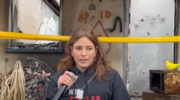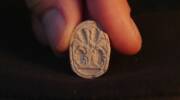Israeli archaeologists uncover one of King David’s palaces, contributing to proof of a central Judean authority during that period.
Hebrew University Professor Yossi Garfinkel and Israel Antiquities Authority’s Sa’ar Ganor recently uncovered what they believe was King David’s Palace at Khirbet Qeiyafa, a fortified city in Judea identified with the biblical city of Sha’arayim. Archaeologists have spent the last seven years on the site, discovering unprecedented evidence of the nature of King David’s reign. “The ruins are the best example to date of the uncovered fortress city of King David,” Garfinkel and Ganor say. “This is indisputable proof of the existence of a central authority in Judah during the time of King David.”
Garfinkel and Ganor note that the palace’s southern end extended across an area of roughly 1,000 square meters (10,700 square feet) at the top of the city. The wall that enclosed the palace was about 30 meters (100 feet) long and featured an impressive entrance through which one descended to the southern gate of the city, opposite the Valley of Elah. They also discovered a number of rooms around the palace’s perimeter showing evidence of a metal industry, with pottery vessels and fragments of alabaster vessels clearly imported from Egypt.
Like the ancients, today’s visitors have “an excellent vantage looking out into the distance, from as far as the Mediterranean Sea in the west to the Hebron Mountains and Jerusalem in the east,” Garfinkel and Ganor note. “This is an ideal location from which to send messages by means of fire signals. Unfortunately, much of this palace was destroyed 1,400 years later when a fortified farmhouse was built there in the Byzantine period.”
Garfinkel said his team found objects typically used by King David’s Jewish subjects and that there were no traces of pig, a sign that the palace belonged to Jews and not members of the ancient pagan nations that inhabited the Land of Israel, such as the Canaanites. Clues like these, he said, were “unequivocal evidence” that David and his descendants had ruled at the site.
The discovery adds an important link to the chain of archaeological evidence, the researchers believe. It teaches us about a kingdom that “knew to establish administrative centers at strategic points. To date, no palaces [had] been found that [could] clearly be ascribed to the early tenth century BCE, as we can do now.” The evidence also indicates that Khirbet Qeiyafa was destroyed in one of the battles fought against the Philistines around 980 BCE. “The palace that is now being revealed and the fortified city that was uncovered in recent years are another tier in understanding the beginning of the Kingdom of Judah.”
The discovery also contributes to our understanding of King David’s life. Whereas the Jewish monarch likely primarily lived in Jerusalem in a yet-undiscovered site and visited Khirbet Qeiyafa or other palaces only for short periods of time, Garfinkel believes the site’s placement on a hill indicates that the ruler sought a secure site on high ground during a violent era of frequent conflicts. “The time of David was the first time that a large portion of this area was united by one monarch,” Garfinkel said. “It was not a peaceful era.”
By Rachel Avraham, staff writer for United With Israel
Do You Love Israel? Make a Donation - Show Your Support!
Donate to vital charities that help protect Israeli citizens and inspire millions around the world to support Israel too!
Now more than ever, Israel needs your help to fight and win the war -- including on the battlefield of public opinion.
Antisemitism, anti-Israel bias and boycotts are out of control. Israel's enemies are inciting terror and violence against innocent Israelis and Jews around the world. Help us fight back!






















